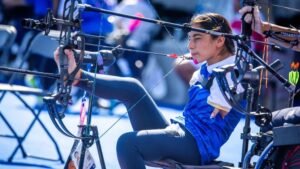
Archery is one of the most ancient sports, known for its blend of physical precision, mental focus, and unwavering determination. At the Paralympic Games, archery holds a special place, not just for its rich history but for the incredible stories of resilience and achievement it represents. As athletes from around the world come together to compete, Paralympic archery showcases the ultimate blend of skill, determination, and inclusive sportsmanship.
The Evolution of Archery in the Paralympics
A Sport Rooted in Ancient History
In the context of the Paralympic Games, archery was first introduced in Rome in 1960, becoming a symbol of how sports can be adapted to suit athletes of all abilities.
The inclusion of archery in the Paralympics has grown significantly over the decades, with more athletes and countries participating each year. The sport has become a testament to the idea that physical challenges do not limit one’s ability to achieve greatness.
The Rules and Classifications in Paralympic Archery
Understanding the Classifications
Paralympic archery is inclusive of athletes with a variety of physical impairments. The main classifications include:
- W1: Athletes with an impairment in all four limbs, often using wheelchairs and requiring specialized equipment.
- Open: Athletes with impairment in the lower limbs, who may shoot from a standing or seated position.
These classifications allow athletes to compete on an even playing field, ensuring that the focus remains on skill and precision rather than physical differences.
Equipment and Techniques
In Paralympic archery, athletes use a range of specialized equipment, tailored to their needs. Some may use recurve bows, while others use compound bows, depending on their classification. Additionally, assistive devices such as mouth tabs, mechanical releases, or custom grips are allowed to help athletes maximize their potential.
The rules and regulations in Paralympic archery mirror those of the Olympic Games, with athletes competing at a distance of 70 meters for recurve bows and 50 meters for compound bows. The targets feature 10 concentric rings, with scores ranging from 1 to 10 points, depending on where the arrow lands.
The Road to the Paralympics: Training and Challenges
The Rigorous Training Regimen
Training for Paralympic archery is no less demanding than any other high-level sport. Athletes must develop a strong mental focus, as the sport requires an incredible amount of concentration. Hours of practice are dedicated to perfecting posture, release, and aiming techniques. Moreover, the physical demands of drawing and holding a bow require significant upper body strength, especially for athletes using specialized equipment.
Many Paralympic archers also undergo rigorous physical therapy to maintain and enhance their mobility, ensuring they remain at the peak of their performance. The journey to the Paralympics is paved with dedication, resilience, and an unyielding drive to excel.
Overcoming Physical and Psychological Barriers
For many Paralympic archers, the sport is not just about competition; it is a powerful tool for rehabilitation and self-empowerment. The mental fortitude required to excel in archery often helps athletes overcome psychological barriers, fostering a sense of confidence and self-worth. Competing on the world stage further amplifies their message of perseverance, showing that challenges can be transformed into strengths.
Archery at the Paris Paralympics 2024: What to Expect
A Showcase of Talent and Resilience
The Paris Paralympics 2024 promises to be a spectacular event for archery enthusiasts. Athletes from around the globe will gather to demonstrate their extraordinary skills, making it a must-watch event. The competition is expected to be fierce, with top archers vying for gold and the honor of representing their countries.
The event will also highlight the latest advancements in adaptive sports technology, showcasing how innovations continue to enhance the performance of Paralympic athletes. From cutting-edge equipment to improved training methodologies, the 2024 Games will be a testament to the evolution of the sport.
Inspiring a New Generation of Athletes
One of the most significant impacts of Paralympic archery is its ability to inspire future generations. Watching Paralympic archers defy the odds and excel at their sport sends a powerful message to young people with disabilities: that they too can achieve greatness in sports. The visibility and success of Paralympic archers play a crucial role in changing perceptions about disability, encouraging inclusivity, and promoting the idea that sports are for everyone.
Conclusion: The Legacy of Paralympic Archery
More than just a competitive event, Paralympic archery stands as a powerful symbol of resilience, inclusivity, and the boundless potential within each individual. As we look forward to the Paris Paralympics 2024, the world will witness not just the precision of arrows hitting their targets, but the extraordinary journey of athletes who have overcome immense challenges to stand on the world stage. Their experiences, marked by determination and triumph, inspire us all, showing that with unwavering passion and perseverance, anything can be accomplished.
For more insights and updates on the Paralympics and other global sports events, visit American Pulse.
For more information, visit this link.
Suggested Tags: Paralympic archery, adaptive sports, Paralympics 2024, Paris Paralympics, archery training, inclusive sports, adaptive technology, Paralympic athletes, archery competition, global sports events.
